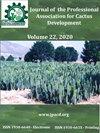氮、磷、钾对墨西哥伊达尔戈Huichapan地区龙舌兰有机基质的影响
IF 0.4
4区 农林科学
Q4 HORTICULTURE
Journal of the Professional Association for Cactus Development
Pub Date : 2022-08-22
DOI:10.56890/jpacd.v24i.511
引用次数: 0
摘要
墨西哥有159种龙舌兰,在农业食品工业中最突出的是龙舌兰、agustifolia和salmiana。生产maguey幼苗的一个限制是有利于植物在田间适应的有机基质的有效性低。目的是评价底物中氮(N)、磷(P)和钾(K)对墨西哥伊达尔戈Huichapan农业区salmiana营养和根系生长的影响。以蚯蚓腐殖质(EH)和叶片堆肥(LC)为基质,采用不同比例的EH(100、75、50%)、LC(5、10%)和砂(20、40%)。在种子和40 d的幼苗上随机重复14次。评估的变量是NPK量和底物pH。测量的生理变量包括株高、叶数、茎粗、根长和体积。不同处理对幼苗生理机能有显著影响(P?0.05)。龙舌兰幼苗的最佳农艺反应(植株生长和根长/重)为T5(75%蚯蚓腐殖质+ 20%砂+ 5%叶土)和T6(50%蚯蚓腐殖质+ 40%砂+ 10%叶土);在两个处理中,氮磷钾百分比与对照(Haplic Phaeozem土)组不同。T6氮磷钾最终浓度为N = 0.04%, P = 398.13 mg Kg-1, K = 11.88 meq 100g-1。结果表明,土壤氮磷钾有效性和基质的逐渐酸化(初始pH = 8.6,最终pH = 7.4)有利于影响植物的响应。基材中氮磷钾有效性与其对maguey幼苗适应性的更好响应之间的相互作用为墨西哥伊达尔戈Huichapan地区生产系统的研究开辟了新的思路。本文章由计算机程序翻译,如有差异,请以英文原文为准。
Effect of Nitrogen, Phosphorus and Potassium on regional organic substrates in Agave salmiana production in Huichapan, Hidalgo, Mexico
Mexico has 159 species of Agave spp. In the agri-food industry stand out are Agave tequilana, A. angustifolia, and A. salmiana. A limitation to producing maguey seedlings is the low availability of organic substrates that favor plant adaptation in the field. The objective was to evaluate the effect of nitrogen (N), phosphorus (P) and potassium (K) found in substrates in response to vegetative and root growth of A. salmiana in agricultural areas of Huichapan, Hidalgo, Mexico. The treatment consisted of earthworm humus (EH) and leaf compost (LC) substrates with materials from the region with different percentages of EH (100, 75, 50%), LC (5, 10%), and sand (20, 40%). The treatments were applied with 14 random replications in two phases in seeds and 40-day-seedlings. The variables evaluated were NPK amount and pH in substrates. The physiological variables measured were plant height, leaf number, stem diameter, root length, and volume. Significant differences (P?0.05) were observed in seedling physiology due to the effect of the treatment. The best agronomic responses (plant growth and root length/weight) of Agave seedlings were T5 (75% earthworm humus + 20% sand + 5% leaf-soil) and T6 (50% earthworm humus + 40% sand + 10% leaf-soil); in both treatments, the NPK percentages were different from the control (Haplic Phaeozem soil) group. The final concentration of NPK in T6 was N = 0.04%, P = 398.13 mg Kg-1 and K = 11.88 meq 100g-1. The results infer that NPK availability in soil and progressive acidification (initial pH = 8.6, final pH = 7.4) of the substrate can favorably influence the plant response. The interactions between NPK availability in the substrate and their use for a better response in maguey seedling adaptability open up new lines of research on the productive systems in the region of Huichapan, Hidalgo, Mexico.
求助全文
通过发布文献求助,成功后即可免费获取论文全文。
去求助
来源期刊

Journal of the Professional Association for Cactus Development
Agricultural and Biological Sciences-Plant Science
CiteScore
1.10
自引率
33.30%
发文量
10
期刊介绍:
The editors of the Journal of the Professional Association for Cactus Development, are very excited to be a part of the excellent editorial committee and to work together to create the synergism between scientists, growers, legislators, and business people so vital to the development of this industry to serve the people of arid lands.
 求助内容:
求助内容: 应助结果提醒方式:
应助结果提醒方式:


